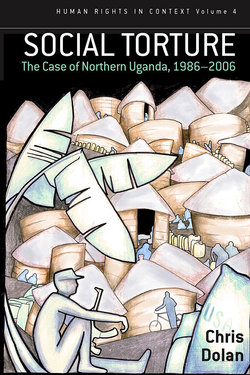Читать книгу Social Torture - Chris Dolan - Страница 7
На сайте Литреса книга снята с продажи.
ОглавлениеFOREWORD
How to address a war as destructive and long-running as that in northern Uganda? Chris Dolan's startling and original answer begins with the observation that this has not really been a war at all. Though typically portrayed as a military contest between the rebel Lord's Resistance Army and the government (the parties that signed a fragile cessation of hostilities in 2006), the conflict is better understood – Dolan argues – as a form of ‘social torture’ that has maintained local populations in a position of ‘subordinate inclusion’.
The key instrument here has been the camps or ‘protected villages’ into which hundreds of thousands of people were concentrated, ostensibly (as the name implies) for their own protection. In this sense, humanitarian agencies have been complicit in ‘social torture’. Dolan notes that a great many Ugandans used the word ‘torture’ to describe their own experience in the war. Then he shows how ‘in the name of protection, the population experienced on a mass scale the key elements of torture, most notably violation, debilitation and humiliation’. A sense of uncertainty and lack of control were pervasive. This in turn fed into other kinds of violence, for example when some of the encamped men, having lost their ability to protect and provide for their families, embraced more violent definitions of masculinity and various forms of domestic abuse. Indeed, the persistence of violence more generally reflects, in part, the process by which victims have frequently become perpetrators. Meanwhile, blame has been internalised by the victims, not least by the Acholi ethnic group that has born the brunt of
the violence. In these circumstances, using the label ‘post-traumatic stress disorder’ becomes inappropriate since the trauma is ongoing: in fact, the label becomes part of ‘a structure of denial’.
Dolan emphasises that the rebels could have been overcome with a coherent military strategy that did not alienate large numbers of civilians. Government depredations have been much less publicised or criticised than those by the rebels, and this is in line with many other contemporary conflicts where government actors have been given an easier ride than rebels. Significantly, when peace has appeared possible, government actors have frequently sabotaged it.
The point of all this prolonged and intense suffering, Dolan emphasises, was not so much to defeat the insurgency as to send a sharp message to the Acholi people as a whole as well as to other potentially restive social groups in other parts of the country. In this sense, the study resonates with other cases – including wars in Sierra Leone and Guatemala as well as the ‘war on terror’: the war is not simply against the ‘named enemy’ and the imprecision of the response to insurgency and terror, whilst alienating many people, serves a function in sending a message of intimidation to a much wider group.
This study is sure to provoke controversy, and never more so than when the author says of many donors, NGOs, multilateral organisations and churches: ‘…like doctors in a torture situation, they appear to be there to ease the suffering of victims, but in reality they enable the process to be prolonged by keeping the victim alive for further abuse.’ Dolan is not pulling any punches. He draws on very detailed local knowledge. It is a beautifully written book, disturbing and revealing. The analysis is clear and incisive. And crucially, Dolan gives a voice to some of those who have been silenced by the common view that war is simply a contest between one ‘side’ and the other. I believe this book will become a landmark in the study of aid and conflict.
– David Keen
